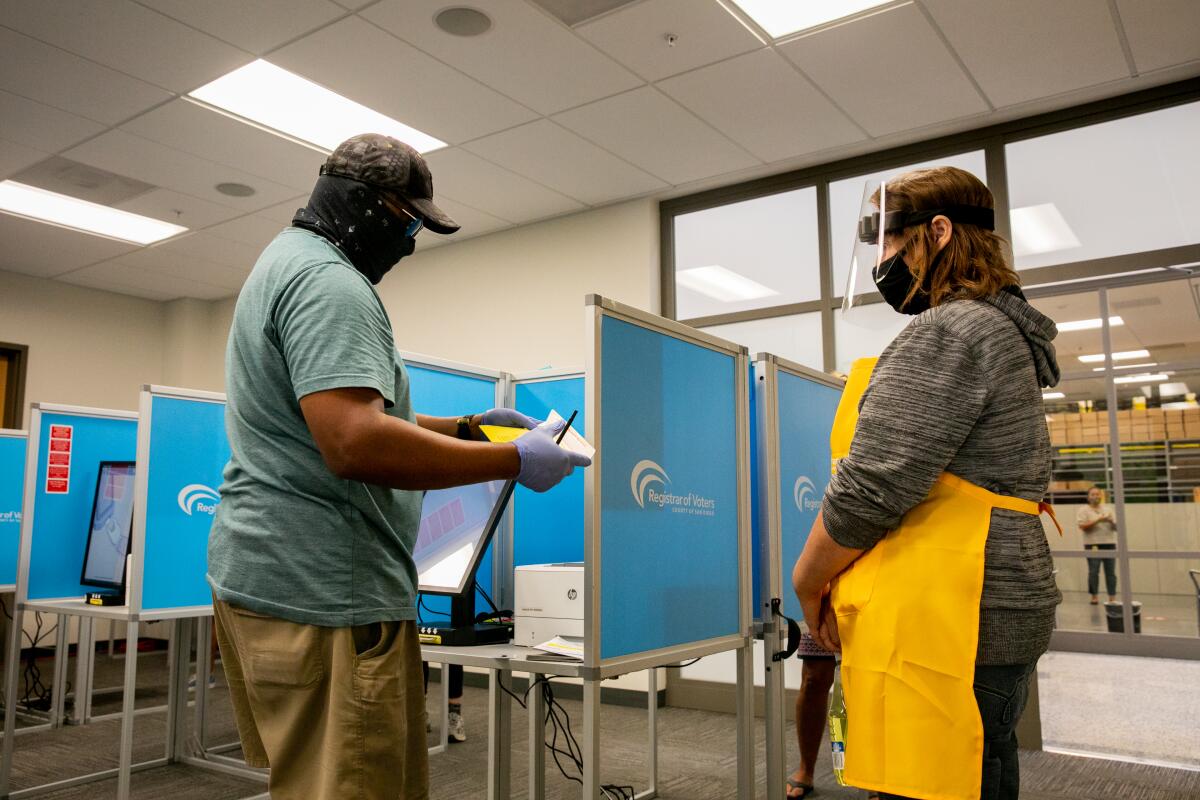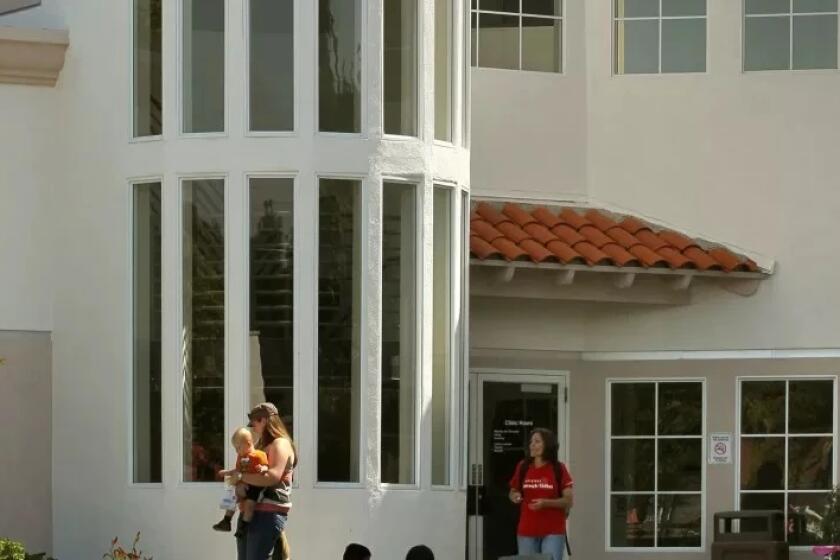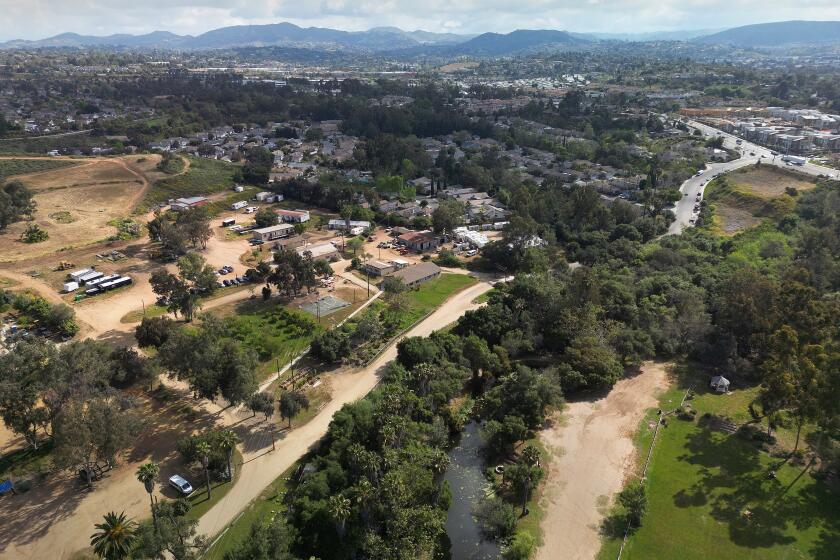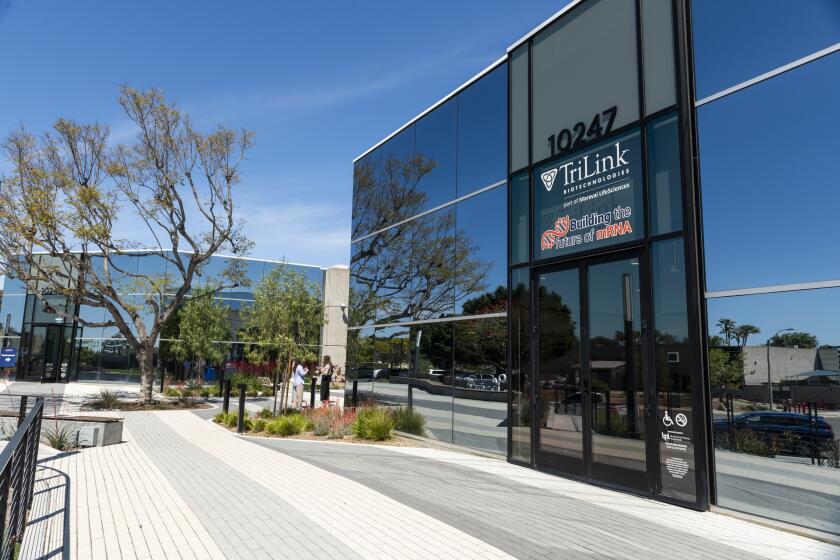Sneeze guards, hand sanitizer, disposable gloves: County preps for safe polling places

Voters will have four days to cast in-person ballots
No one knows whether 2020 will be the biggest election in history, but it is already clear that it will be the cleanest, especially in San Diego County.
During a weekly COVID-19 briefing, Michael Vu, the county’s registrar of voters, outlined the procedures that will be in place during an extended four-day, in-person, ballot-casting period this year. The region’s top election official calmly ticked off a list of supplies that sounded like he was setting up a mobile field hospital, rather than a series of 235 “super polling” places.
In addition to ballots, more than 4,500 volunteers and plenty of “I voted” stickers, the list of what it takes to safely run an election in 2020 with coronavirus still spreading among the populace includes 1,800 sneeze guards, 800,000 disposable gloves, 300,000 masks, 12,000 bottles of hand sanitizer and 25,000 tubs of sanitizing wipes.
The goal, Vu said, is to keep polling places from popping up as a new category of outbreak locations in the county’s daily coronavirus status reports.
“The election is Nov. 3. I do not want to be standing here 14 days later talking about election day as a statistic,” Vu said.
A fresh batch of statistics released Wednesday drove home the point. An additional 263 confirmed coronavirus cases, and six more deaths, were listed in the daily COVID-19 report which also included a half-dozen new community outbreaks.
As she has frequently in recent weeks, Dr. Wilma Wooten, the county’s public health officer, pleaded with the public to do the simple things necessary to slow the spread of infections as kids go back to school in greater numbers and the holidays approach.
San Diego County very nearly fell into the most-restrictive purple tier in Tuesday’s weekly state reopening assessment. Wooten said turning from red to purple came down to just two federal inmates who were erroneously included in the state’s counts, delivering an adjusted rate of 7.1 cases per 100,000 residents, just over the limit of 7 to stay in the second-most-restrictive red tier. Conversations Monday morning with the state got those two cases removed, but it was a very close thing.
Wooten warned the public that it is living on the edge in a way that must change if the region wants to avoid the kind of backsliding that would cause the state to mandate that businesses move their operations outdoors again.
“If people will just make the smallest effort by wearing their facial coverings, social distancing and not going to parties, large crowds or large gatherings, we can turn the tide here,” Wooten said.
While there might not be as much adherence to the guidelines as the county would like, the current flu season does seem to prove that local practices are helping fight the spread of infections from person to person.
In its inaugural report for the 2020-2021 flu season, the county health department disclosed Wednesday that it has received reports of just 10 positive flu tests since July. It is an astoundingly-low number given that there were 320 positive flu tests during the same timeframe last year with a prior three-year average of 239.
The drop is not particularly surprising given that social distancing practices and mask wearing have been mandated since the spring and strictly enforced in the busiest businesses, such as grocery stores.
Weekly flu numbers fell off a cliff in April, dropping from 583 to just 90 in a single week as stay-at-home orders took widespread effect. The reduction of viral transmission that occurred with the closure of schools was so significant that Rady Children’s Hospital was temporarily forced to close an entire intensive care unit pod due to a drop in new cases of all types of viral illnesses.
But it is anybody’s guess exactly what is in store as schools reopen.
To date, 31 local school districts are now operating with at least some in-person instruction, and nine more are set to get underway from Oct. 22 through January, 2021.
Dr. Eric McDonald, medical director of the county epidemiology department, had words of caution for parents: plans designed to lessen the chances of infection on campuses large and small will only keep the virus from coming home at the end of the school day if they are understood and followed.
“Our local school districts and independent schools have done a great job creating plans, but we need to make sure that parents know those plans and can get their families to adhere as closely as they can to those plans,” McDonald said.
Already, the physician noted, the number of cases occurring among those age zero to 19 has blipped upward slightly in early October.
The polling places due to open across the county on Oct. 31 have clearly taken a page out of the operating playbook currently being followed in many schools. One-way paths will be enforced during the election, just as unidirectional movement from class to class has been adopted on many campuses.
Vu said that there would normally be between 1,350 and 1,400 polling places serving about 1,600 voter precincts in a normal election but those sites have been consolidated down to 235 locations with enough square footage to allow for 6-foot spacing at all times.
“There is just not enough space in the typical garage in someone’s home to make sure we have the space that is needed,” Vu said.
The average neighborhood polling place would generally have about four volunteer workers compared to about 15 at the larger locations. In addition to requiring all in-person voters to wear masks and use hand sanitizer before entering polling places , and enforcing 6-foot separation while in line, all pens and styluses used to mark ballots and digitally sign voter logs will be used just once, Vu said, before being set aside for a specified “dwell time” before they can be sanitized and reused.
Get Essential San Diego, weekday mornings
Get top headlines from the Union-Tribune in your inbox weekday mornings, including top news, local, sports, business, entertainment and opinion.
You may occasionally receive promotional content from the San Diego Union-Tribune.












